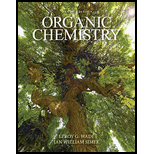
Concept explainers
(a)
To determine: The classification of given monosaccharides.
Interpretation: The name of the given aldose is to be stated.
Concept introduction: A carbohydrate that does not undergo hydrolysis of glycosidic bonds to give smaller sugar molecules is known as monosaccharide. Aldose is a monosaccharide which contains an
(b)
To determine: The classification of given monosaccharides.
Interpretation: The name of the given aldose is to be stated.
Concept introduction: A carbohydrate that does not undergo hydrolysis of glycosidic bonds to give smaller sugar molecules is known as monosaccharide. Aldose is a monosaccharide which contains an aldehyde carbonyl group.
(c)
To determine: The classification of given monosaccharides.
Interpretation: The name of the given aldose is to be stated.
Concept introduction: A carbohydrate that does not undergo hydrolysis of glycosidic bonds to give smaller sugar molecules is known as monosaccharide. Aldose is a monosaccharide which contains an aldehyde carbonyl group.
(d)
To determine: The classification of given monosaccharides.
Interpretation: The name of the given aldose is to be stated.
Concept introduction: A carbohydrate that does not undergo hydrolysis of glycosidic bonds to give smaller sugar molecules is known as monosaccharide. Aldose is a monosaccharide which contains an aldehyde carbonyl group.
(e)
To determine: The classification of given monosaccharides.
Interpretation: The name of the given aldose is to be stated.
Concept introduction: A carbohydrate that does not undergo hydrolysis of glycosidic bonds to give smaller sugar molecules is known as monosaccharide. Aldose is a monosaccharide which contains an aldehyde carbonyl group.
(f)
To determine: The classification of given monosaccharides.
Interpretation: The name of the given aldose is to be stated.
Concept introduction: A carbohydrate that does not undergo hydrolysis of glycosidic bonds to give smaller sugar molecules is known as monosaccharide. Aldose is a monosaccharide which contains an aldehyde carbonyl group.
(g)
To determine: The classification of given monosaccharides.
Interpretation: The name of the given aldose is to be stated.
Concept introduction: A carbohydrate that does not undergo hydrolysis of glycosidic bonds to give smaller sugar molecules is known as monosaccharide. Aldose is a monosaccharide which contains an aldehyde carbonyl group.
Want to see the full answer?
Check out a sample textbook solution
Chapter 23 Solutions
Organic Chemistry Plus Mastering Chemistry with Pearson eText -- Access Card Package (9th Edition) (New in Organic Chemistry)
- What is the product of the following reaction? Please include a detailed explanation of what is happening in this question. Include a drawing showing how the reagent is reacting with the catalyst to produce the correct product. The correct answer is IV.arrow_forwardPlease complete the reactions, thank youarrow_forwardConsider the synthesis. What is compound Y? Please explain what is happening in this question. Provide a detailed explanation and a drawing to show how the compound Y creates the product. The correct answer is D.arrow_forward
- What would be the major product of the following reaction? Please include a detailed explanation of what is happening in this question. Include steps and a drawing to show this reaction proceeds and how the final product is formed. The correct answer is B. I put answer D and I don't really understand what is going on in the question.arrow_forwardWhat is the product of the following reaction? Please explain what is happening in this question. Provide a detailed explanation and a drawing showing how the reagent is reacting with the catalysts to product the correct product. The correct answer is B.arrow_forwardWhat is the missing intermediate 1 and the final product 2. Please include a detailed explanation explaining the steps of malonic ester synthesis. Please include drawings of the intermediate and how it occurs and how the final product is former.arrow_forward
- What would be the reagents and conditions above and below the arrow that will complete the proposed acetoacetic ester synthesis? If it cannot be done efficiently, then I will choose that answer. There could be 2 or 4 reagents involved. Please provide a detailed explanation and drawings showing how it would proceed with the correct reagents.arrow_forwardFor benzene, the ∆H° of vaporization is 30.72 kJ/mol and the ∆S° of vaporization is 86.97 J/mol・K. At 1.00 atm and 228.0 K, what is the ∆G° of vaporization for benzene, in kJ/mol?arrow_forwardThe reaction Q(g) + R(g) → Z(l) is shown to be exothermic. Which of the following is true concerning the reaction. it is spontaneous only at High T, it is spontaneous at low T it is nonspontaneous at all T it is spontanrous at all T. it is non spontaneous only at low T.arrow_forward
- The reaction Q(g) + R(g) → Z(l) is shown to be exothermic. Which of the following is true concerning the reactionarrow_forwardWhich of the following has the largest standard molar entropy, S° (298.15 K) He H2 NaCl KBr Hgarrow_forwardWhich of the following is true for a particular reaction if ∆G° is -40.0 kJ/mol at 290 K and –20.0 kJ/mol at 390 K?arrow_forward
- Chemistry: Matter and ChangeChemistryISBN:9780078746376Author:Dinah Zike, Laurel Dingrando, Nicholas Hainen, Cheryl WistromPublisher:Glencoe/McGraw-Hill School Pub Co
 ChemistryChemistryISBN:9781305957404Author:Steven S. Zumdahl, Susan A. Zumdahl, Donald J. DeCostePublisher:Cengage Learning
ChemistryChemistryISBN:9781305957404Author:Steven S. Zumdahl, Susan A. Zumdahl, Donald J. DeCostePublisher:Cengage Learning Chemistry: An Atoms First ApproachChemistryISBN:9781305079243Author:Steven S. Zumdahl, Susan A. ZumdahlPublisher:Cengage Learning
Chemistry: An Atoms First ApproachChemistryISBN:9781305079243Author:Steven S. Zumdahl, Susan A. ZumdahlPublisher:Cengage Learning 
 World of Chemistry, 3rd editionChemistryISBN:9781133109655Author:Steven S. Zumdahl, Susan L. Zumdahl, Donald J. DeCostePublisher:Brooks / Cole / Cengage Learning
World of Chemistry, 3rd editionChemistryISBN:9781133109655Author:Steven S. Zumdahl, Susan L. Zumdahl, Donald J. DeCostePublisher:Brooks / Cole / Cengage Learning Chemistry & Chemical ReactivityChemistryISBN:9781133949640Author:John C. Kotz, Paul M. Treichel, John Townsend, David TreichelPublisher:Cengage Learning
Chemistry & Chemical ReactivityChemistryISBN:9781133949640Author:John C. Kotz, Paul M. Treichel, John Townsend, David TreichelPublisher:Cengage Learning





